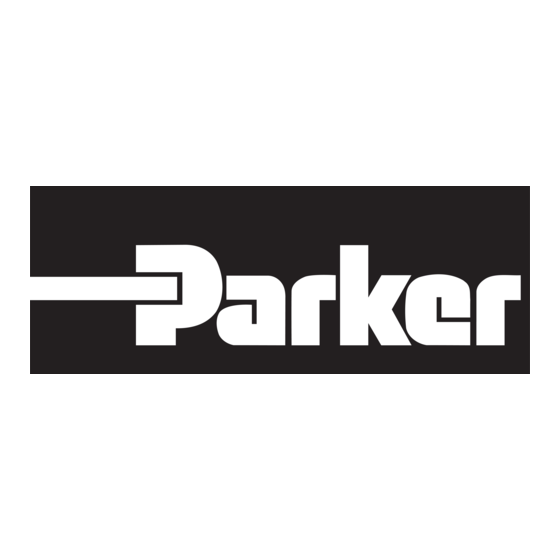Advertisement
Quick Links
Fluid Control Division
Parker Hannifin Corporation
95 Edgewood Avenue
New Britain, CT 06051
Telephone
(860) 827-2300
INSTALLATION, OPERATING, & MAINTENANCE INSTRUCTIONS
2-WAY N.C. AND N.O. SOLENOID VALVES
1/4" NPT
VALVE TYPE 73212, 73222
DESCRIPTION
These valves are 2-way, pilot operated models requiring a minimum
operating Pressure differential to insure valve operation. They are
available in normally closed (N.C.) and normally open (N.O.) versions.
The 73212 and 73222 are offered in brass or stainless steel body
construction. Valves may be ordered with either NEMA 2, 4, 4X
integrated coils for ordinary locations or NEMA 4, 4X, 7, and 9 for
hazardous locations: Divisions I and II; Class I, Groups A, B, C, and D;
Class II, Groups E, F, and G. Additional solenoid coils and enclosures
ae offered as described in our catalog.
PRINCPLES OF OPERATION
73212
Normally closed type:
These valves utilize a plunger to open and close a pilot orifice. Opening
the pilot orifice causes a pressure differential and subsequent piston
assembly shift to open or close the valve's main orifice.
De-energized: Pressure is connected to the inlet port and is trapped
by the plunger on the pilot orifice and by the piston on the main valve
orifice.
Energized: The plunger moves, which opens the pilot orifice, venting
the pressure behind the piston. The venting of pressure enables the
piston to the main orifice, allowing flow through the valve.
Normally open type: 73222
These valves utilize a push operator to open and close the pilot orifice.
Closing the pilot orifice causes a pressure differential shift and
subsequent piston assembly shift to close the valve's main orifice.
De-energized: Pressure is connected to the inlet port and is free to flow
out the outlet port.
Energized: Closing the pilot orifice causes a build up of pressure
behind the piston which shifts the piston to close the main valve orifice.
Flow between the inlet and outlet is then stopped.
CAUSION: A minimum operating pressure differential of 5 psi is
required for proper valve operation.
FLUID CODES
IOM7210
(Rev 1224)
Listed below are the codes utilized by Underwriters Laboratories (UL) and the
Canadian Standards Association (CSA) for various common fluids. The
codes for those fluids that are approved or certified by the agencies for use
with each valve are printed on the outside of the individual packaging.
CODE
FLUID
A
-
Air or nontoxic, nonflammable gases
Ac
-
Acetylene
F
-
Common refrigerants except ammonia
G
-
City gas supplied by public utilities
Ga
-
Gasoline
HO
-
Petroleum based hydraulic oils having viscosities of 125 to
400 SSU at 100°C F (38°C)
02
-
Nos. 1 and 2 fuel oils, oils having viscosities not more than
40 SSU at 38°C
02-06
-
No. 2 through No. 6 oil
OX
-
Oxygen
S
-
Steam
W
-
Water or other aqueous nonflammable liquids
For the maximum fluid temperatures, as well as valve ambient
temperature limitations, check the valve part number on the nameplate
and refer to the catalog or the outside of the shipping package.
INSTALLATION INSTRUCTIONS
Mounting position and pressure limits: Valves can be mounted
directly on piping.
The 73212 and 73222 valves are designed to be multi-poised and so will
perform properly when mounted in any position. However, for optimum
life and performance the valves should be mounted vertically upright so
as to minimize wear and reduce the possibility of foreign matter
accumulating inside the sleeve area.
The inlet and outlet ports of the valves are stamped on the valve body.
The ports in the brass bodied valves 73212B and 73222B are marked
"P" (inlet) and "A" (outlet). The ports in the stainless steel bodied valves
73212S and 73222S have the inlet port marked "Z" and the outlet port
marked "1".
Piping: Remove protective closures from the ports. Connect line
pressure to the inlet port. Use of Teflon tape, thread compound or
sealants is permissible, but should be applied sparingly to male pipe
threads only. Loctite primer #764 and pipe sealant #567 are
Advertisement

Subscribe to Our Youtube Channel
Summary of Contents for Parker 73212
- Page 1 Normally open type: 73222 The 73212 and 73222 valves are designed to be multi-poised and so will These valves utilize a push operator to open and close the pilot orifice. perform properly when mounted in any position. However, for optimum...
- Page 2 For the maximum valve ambient conditions, as well as the fluid recommended when using stainless steel fittings with stainless steel temperatures, check the valve part number on the nameplate and refer bodies. valve to the catalog to determine the maximum temperatures. CAUTION Do not allow foreign particles, Teflon tape, or thread MAINTENANCE...
- Page 3 Any unauthorized work performed on the product by the purchaser or by third parties can impair its function and relieves Parker of all warranty claims and lability for any misuse and resulting damage.













Need help?
Do you have a question about the 73212 and is the answer not in the manual?
Questions and answers